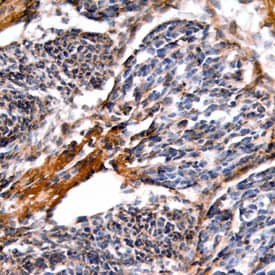Mouse sFRP-3 Antibody
R&D Systems, part of Bio-Techne | Catalog # AF592


Key Product Details
Species Reactivity
Validated:
Cited:
Applications
Validated:
Cited:
Label
Antibody Source
Product Specifications
Immunogen
Ala33-Ser323
Accession # P97401
Specificity
Clonality
Host
Isotype
Scientific Data Images for Mouse sFRP-3 Antibody
sFRP‑3 in Mouse Embryo.
sFRP-3 was detected in immersion fixed frozen sections of mouse embryo (E15) using Mouse sFRP-3 Antigen Affinity-purified Polyclonal Antibody (Catalog # AF592) at 15 µg/mL overnight at 4 °C. Tissue was stained using the Anti-Goat HRP-DAB Cell & Tissue Staining Kit (brown; Catalog # CTS008) and counterstained with hematoxylin (blue). Specific staining was localized to dorsal root ganglia. View our protocol for Chromogenic IHC Staining of Frozen Tissue Sections.Applications for Mouse sFRP-3 Antibody
Immunohistochemistry
Sample: Immersion fixed frozen sections of mouse embryo (E15)
Western Blot
Sample: Recombinant Mouse sFRP-3 (Catalog # 592-FR)
Reviewed Applications
Read 1 review rated 3 using AF592 in the following applications:
Formulation, Preparation, and Storage
Purification
Reconstitution
Formulation
Shipping
Stability & Storage
- 12 months from date of receipt, -20 to -70 °C as supplied.
- 1 month, 2 to 8 °C under sterile conditions after reconstitution.
- 6 months, -20 to -70 °C under sterile conditions after reconstitution.
Background: sFRP-3
Secreted Frizzled Related Protein 3 (sFRP-3) was originally identified in bovine cartilage for its chondrogenic ability. Human, mouse, chick and Xenopus clones have also been isolated. sFRP-3 is often referred to as FRZB, other names also include Fritz, Frzb1, and FRP-3. At the amino acid sequence level, sFRP-3 is highly conserved. The mouse protein shares 76% identity with Xenopus and 92% with human proteins. The gene for mouse sFRP-3 has been localized to the central region of chromosome 2. Murine sFRP-3 is expressed in the primitive streak during gastrulation, as well as in the retina, foregut diverticulum, nervous system, and posterior mesoderm during development. In adult tissues, sFRP-3 expression, as determined by Northern blot, is detected in the heart, brain, spleen, skeletal muscle, kidney, and testis.
The N-terminal portion of sFRP-3 protein shows 50% amino acid identity to the corresponding region of the Drosophila frizzled gene product, a receptor for Wg/Wnt signals. The similarity of sFRP-3 with frizzled proteins is restricted to the N-terminal cysteine-rich domain (CRD) that contains at least ten cysteine residues with highly conserved spacing between them. sFRP-3 was subsequently shown to be a soluble antagonist of Wnt signals. It lacks all transmembrane domains of frizzled proteins but retains the ability to bind Wnts. Ectopic expression of sFRP-3 mRNA has been shown to interfere with the induction of secondary axes in Xenopus embryos injected with Xwnt-8 mRNA.
References
- Hoang, et al. (1996) J. Biol. Chem. 271:26131.
- Leyns, et al. (1997) Cell 88:747.
- Wang, et al. (1997) Cell 88:757.
- Mayr, et al. (1997) Mech. Dev. 63:109.
- Rattner, et al. (1997) Proc. Natl. Acad. Sci. USA 94:2859.
Long Name
Alternate Names
Gene Symbol
UniProt
Additional sFRP-3 Products
Product Documents for Mouse sFRP-3 Antibody
Product Specific Notices for Mouse sFRP-3 Antibody
For research use only